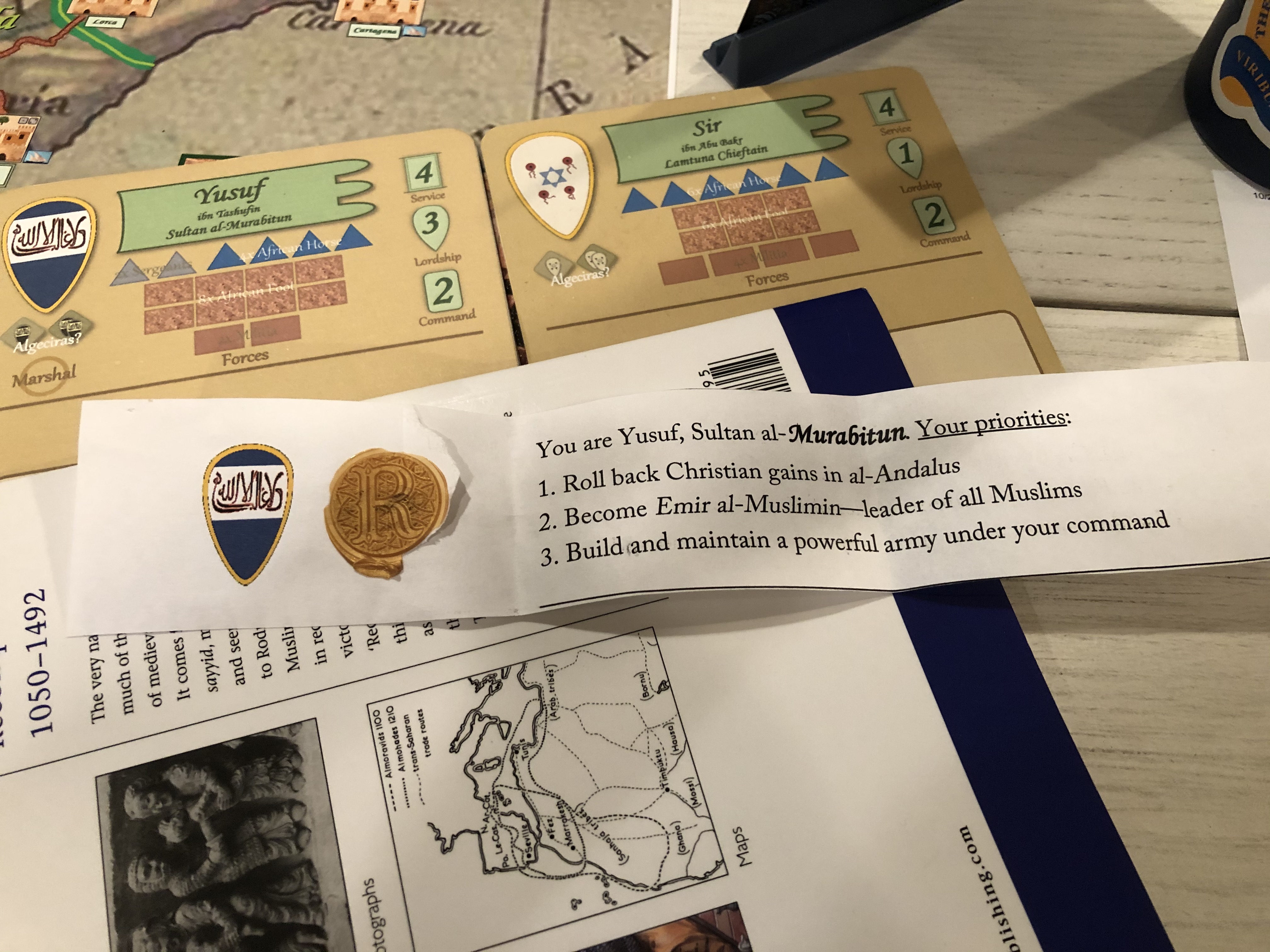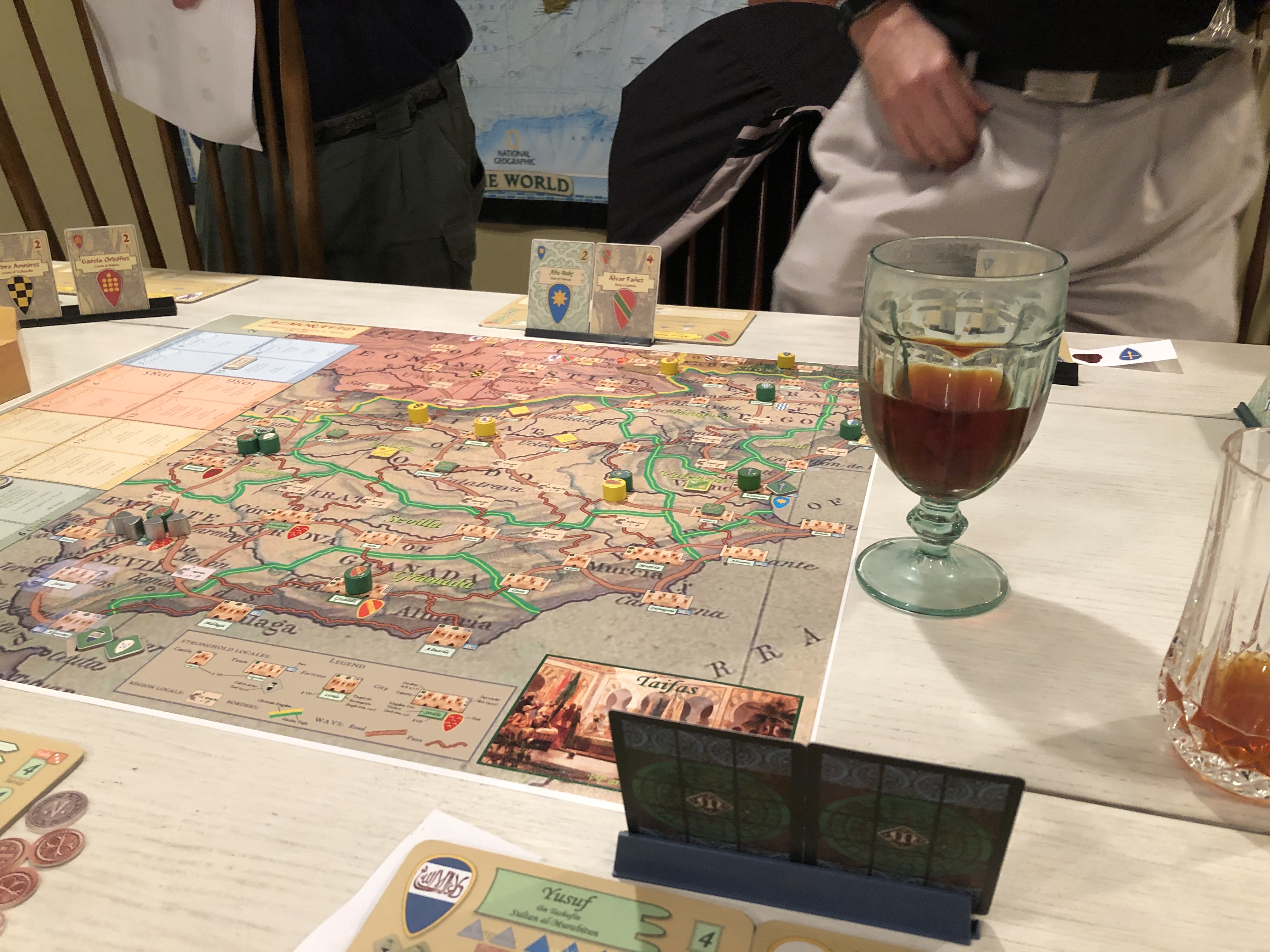Almoravid and the Matrix Game Experiment
Recently I was invited to be a part of a gaming experiment at the home of wargame designer If you are an avid wargamer you already know who he is, for those not familiar with his work you really need to check out some of his games in the COIN Series from GMT Games.
These games focus on counter insurgency operations during conflicts such as Vietnam, Afghanistan, and the Global War on Terror and focus on politics as much as military operations. The series has won many well-deserved awards and is groundbreaking in expanding our hobby beyond pushing troops around a map.
The new game Volko is working on called deals with the fighting and political intrigue between the Moors and Christians in 1085-1086. Other than the name El Cid, I know little about the history of this period however from playing the game I can tell it’s full on twists, turns, and bloodshed. Almoravid is still in development and follows the mechanics of the other games he has worked on such as the game Nevsky that will be available from GMT in the next week or show.
What made this playtest interesting is how Volko turned the two-player board game into a . I am sure that many of you are unfamiliar with this term since it is not something we do very much on the hobby gaming side. To state it very simply a matrix game is much like a combination of a standard war game with a role playing game. It consists of two “sides” which compete against each other and a “White Cell/ Adjudication team” that determines the outcomes of each turn of the game.
The procedure is also quite simple, at the start of the game the White Cell briefs the teams on the situation at hand then the teams leave the game table to work out their “moves” in private for the current turn. After each team has determined their course of action the teams reconvene and brief their move to the White Cell and their opponents. Once both sides have given their moves with rationale on why it would succeed, the White Cell, based on the strengths of each side’s arguments adjudicates the outcome of the move.
The adjudication can be based upon a lot of factors besides a strong and convincing argument, in the Department of Defense, we use matrix games for many of our wargames and often use modeling and simulation, academic studies and subject matter expertise to determine a turn’s outcome. With this game style you can move the game experience to include the political aspects of a conflict such as making and dissolving alliances or negotiating a treaty.
A matrix game may not be great in all situations, obviously, games that cover the operational to the strategic level of gaming would be a good baseline for a matrix game and it is easy to see why a tactical situation may not be the best use of this methodology. You also need to give your players clear instructions and goals so they do not go too far astray from the focus of the game.

This type of gaming may not appeal to a lot of gamers. A player really needs to analyze the situation and provide factual data in order to make their points in what really is a mini debate, so the ability to articulate one’s thoughts is a key quality.
From seeing how Volko briefed us and adjudicated our moves the “White Team” lead needs to be an expert on the subject matter of the game and not everyone has the talent or ability to do this. The research he put into developing the Almoravid board game was evident during our game and despite not knowing much about this period of history I left with a greater appreciation of the subject matter.

While my explanation of matrix gaming is simply the results are not. Many groups/agencies use matrix games to conduct an analysis of strategies, force development and to determine a course of action. Having a multi-disciplinary team develop your team’s move usually leads to a solution that covers many aspects a game may not cover. During Almoravid, the players talked about logistics quite a bit and the White Cell took those logistics based arguments into account when they adjudicated a move.
Based on what was written above I do not want you to think that the game revolves around who has the best argument. Matrix gaming does have a mathematical element to it, while it’s like a CRT we see in most games it is based on probabilities taking all arguments into account. This creates the generation of the random results that many games have in their mechanics.
The Almoravid us rolling d10 dice based on a probability scale, so if the White Cell thought the players move had a 4 in 10 chance of succeeding you would roll a d10 and a 1 means that the move/plan went much better than expected why a 10 would be the worst possible result. So in the example above a roll of 5 would mean that the plan/move failed but not by very much so the adjudicator would display the results accordingly.
In order to teach matrix gaming to my co-workers, I have been working on modifying the game into the matrix format. I feel this game is a good candidate; it has a strategic to operational level scope (WW2 in the Pacific 1941-1945), it has the option for multiple players (US Army, US Navy, China, IJN, IJA, and the Commonwealth, the board and playing pieces are contained in the game along with the mechanics. From reading the rules I know I would have to change the game turns from representing 3 months to 6 and modify the CRT to inform a moves probability use a d10 vice a d6.

The onus of making this game work in the matrix format is on me and my fellow White Team members, we really have to be able to explain the outcomes and our rationale on the fly. One task I know I must have is giving each player, regardless of faction a set of goals that may be unique to them and kept secret from the other players.
In WW2 the IJA and IJN really did not work in a coordinated manner and would, therefore, have some similar goals (win the war) however some operational decisions would be different such as the IJA would want to win the land war in China\Burma\India while the IJN would focus on destroying the US fleet and capturing islands.
Think of how a game can be expanded by this mechanic; while China was an ally of the US and UK during the war an active Chinese player may see that their goals being better met by siding with Japan and may switch sides. The question is now for the White Team, does this switch by China make sense within the bounds of the game? Is it a possible event? What is the probability this would happen?

The Almoravid had two distinct sides however each side had two players that represented different factions and one player ran the games wild card El Cid. During each planning phase we would talk to El Cid and tell him what we were willing to do for his support with the other side doing the same. El Cid acted in what I like to call “Left Shark” mode and made decisions based on his desire to fulfill all of his faction’s secret goals. You can easily see how much fun this was to play out.
The question now remains is does matrix gaming have much to offer to the hobby gamer and like most subjective questions the answer is most certainly “it depends”. Many games are just not good baselines for a matrix modification and as stated above tactical level games just would not work in this format. The other factor one should consider is the sweat equity a facilitator has to put into making the needed modifications to a game that already works in the non-matrix format. Another factor to consider is finding players who would be willing to “role play” a wargame and have the experience and do the research to participate.

I am really looking forward to seeing how Almoravid turns out as it nears publication. Based on my afternoon with Volko I know he has put a lot of work into the game and it should be an instant classic like many of his other titles. I also would love to hear if any of you have conducted a Matrix style game or have the desire to create one.
